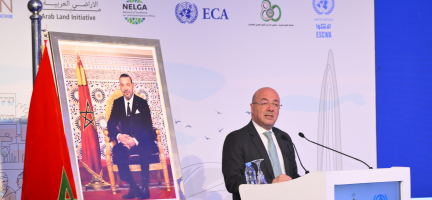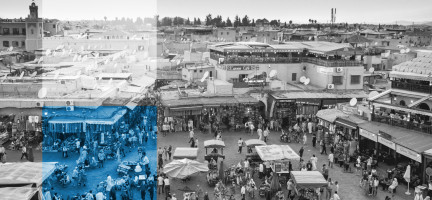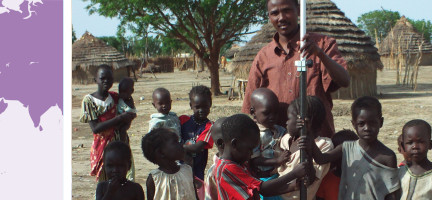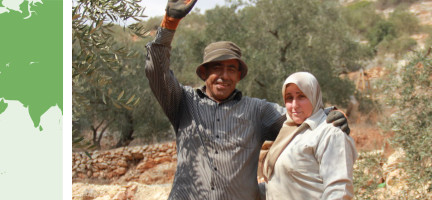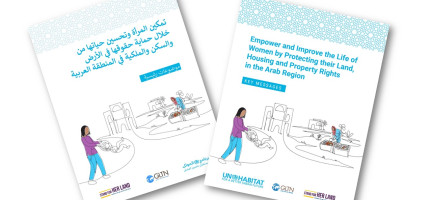المغرب
الصفحة قيد الإنشاء.
شارك مع مبادرة الأراضي العربية وثائق ,منشورات وغيرها من المعلومات التي يمكن عرضها هنا. اكتب إلى unhabitat-arablandinitiative@un.org
Legal and Institutional Framework
Morocco’s 2011 Constitution considers urbanism, land management and the regimes of public, private and collective real property to be domains of the law, with provisions for some areas laid out in the Constitution. Article 31 states that the State and its public institutions work to achieve equal access for men and women to decent housing, among other rights. Article 35 guarantees the right to property, the freedom to enter into contracts and free competition, and also affirms the right of the State to expropriate land for economic and social development as provided by law [2].
Morocco is a legally pluralistic country, with statutory and customary laws. The formal system is based on French civil law, while customary law is based on Islamic Sharia law and, for some communities, the traditional though informal Amazigh justice system [3][4]. Statutory law generally governs large commercial land transactions, while customary law is generally used when dealing with residential land in informal settlements and rural areas. The extent to which statutory laws are used depends on a number of factors, including location of the land and how land is typically controlled locally. In some areas of the country people may not be aware of relevant statutory laws, or they may be known but not enforced, such as in areas with strong traditional leadership or many rural areas [4].
Morocco lacks a formal land policy, and its statutory laws governing land rights and administration are both fragmented and not comprehensive. Statutory law relevant to land, which includes decrees (dahir) and laws that regulate some aspects of land administration, are largely based on French civil code. The main sources of land and property legislation in Morocco include decrees and laws which:
Require the registration of land rights (decrees of 12th August 1913 and 2nd and 4th June 1915);
Provide for formal collective land rights within irrigated perimeters (Decree 1.69.30);
Establish a framework to delimit collective land (1924);
Protect against land fragmentation by restricting partition of land (Law No.34.94 of 1994) [4].
Under Law 7 of 1981, the State is permitted to expropriate land for public necessity or temporary use. The amount given to the landowner for compensation is based on negotiation, and if an amount cannot be agreed upon a committee of local officials determines the amount based on market value. This law has been used to expropriate land for urban development [4].
The management of forests is governed by more than 30 laws and decrees, with the decrees of 1917 and 1976 being the primary legal instruments for forest governance. The Forest Protection and Exploitation decree of 1917 provides for State ownership of forests, allowing some user rights such as grazing for local communities. The decree of 1976 increased local government control over forestland and rights to forest products and provides for local community participation in forest management. However, customary law governs much of the country’s forested lands [4].
Decree 1.03.59 of 2003 provides for environmental requirements related to real estate development and transactions [5].
Customary law with respect to land is used in much of Morocco, particularly in rural and informal settlement areas. Lineage, inheritance and property transfer as established by Islamic law and local customary norms govern land access in these areas. Despite the updated Family Code of 2004, customary law may still govern inheritance rights in many cases [4].
Morocco’s Ministry of Agriculture and Maritime Fisheries oversees development of policies that impact the country’s agricultural lands, while the regional directorates implement those policies at the provincial and local levels. The State acts as trustee to communal tribal lands through its Trusteeship Councils, which also hear land disputes and review land allocations. At the local level, provincial and local-level government officials manage land use and administration [4].
In 2019, Morocco’s Committee on the Interior, Territorial Communities, Housing and Urban Policy adopted three new laws that delimited and effectively ended the inalienable status of some collectively held Amazigh lands, giving power to the State to sell, transfer or lease these lands. Prior to the adoption of these laws, such collective lands could not be sold, transferred or rented, but could, under certain conditions, be used for State projects for public interest [6]. Moreover, Morocco is embarking on a project of melkinization of collective lands, whereby the State divides collective lands into plots and distributes them as private property to those living on the land. The stated purpose of the initiative is to encourage investment in agricultural development and registration of agricultural land [7][8].
In 2019 the Government of Morocco commissioned a study from the Economic, Social and Environmental Council (CESE) to identify shortcomings of the national land policy and propose recommendations to remedy them [9]. Among the recommendations were:
Eliminating development constraints in urban spaces to attract investment and offering dignified and accessible housing;
Initiating progressive reform of the status of collective lands to alleviate constraints on rural development, while taking into account the imperatives of environmental sustainability;
Putting in place a legal framework that governs the land sector as a whole and guarantees security of tenure while considering the specificities and respective roles of each land tenure system;
Establishing an effective and efficient land governance framework and instruments able to adapt to changes on demand.
Land Tenure
Several land tenure types exist in Morocco.
The most common is collective tribal land ownership, with individuals within the tribes having usufruct rights and the State acting as trustee to such land. Around 15 million hectares of land in Morocco falls into this category [21]. The specific individual rights of tribal members are based largely on social status, political power and ability to invest in the land. Tribal members engaged in agriculture are typically granted perpetual use rights. Collectively held land cannot be transferred outside of the tribe, and the vast majority of the land (98 per cent) is individualized and heritable in accordance with customary law.
The State owns about 30 per cent of land. Public lands include parks, rangeland, forests and other public lands. State’s private domain comprises properties not for public use, including 400,000 hectares of agricultural land acquired through expropriation. The State allows leaseholds of up to 40 years on state-owned land.
Guich land is land in the State’s private domain that has been given by the monarchy to members of the military, who, as occupants, hold usage rights. This amounts to around 210,000 ha.
Approximately 28 per cent of land in Morocco is melk, or privately owned, freehold land, meaning the landowner has the right to exclusive possession, use and transfer of the land. The rate is significantly higher for agricultural land, 76 per cent of which is melk. The majority of melk (71 per cent) is owned jointly by two or more usually multigenerational families, and most commonly acquired by inheritance, though it can also be obtained through purchase or prescription. Melk is rarely sold to third parties outside of the family, and the market for agricultural land is very limited.
About 100,000 hectares of land, 60 per cent of which is agricultural land, is owned by religious (primarily Islamic) orders. This endowed, or habous, land is often donated by wealthy individuals to a mosque or church. Habous land cannot be sold but may be leased or loaned for agricultural cultivation [4].
The Government of Morocco has allocated a limited amount of state land – around 320,000 ha – to roughly 22,000 landless and smallholder farmers through its land reform programme since 1969. These farmers received government-subsidized loans to purchase the land, though they did not receive freehold title and cannot transfer or lease the land to third parties [10].
Land registration system
Morocco has two systems of land registration reflecting the plural legal system governing land rights: the formal system requires that land rights are registered in the National Agency for Land Conservation, Cadastre and Cartography (Agence Nationale de la Conservation Foncière, du Cadastre et de la Cartographie, or ANCFCC), under the formal supervision of the Ministry of Agriculture [21], while registration of land rights in the customary system are maintained by local traditional leaders. Around 30 per cent of land is registered in the formal system, the vast majority of which is in urban areas [4].
The land registration system in Morocco is governed by Law 14-07 [11] which supplements and modifies the decree (Dahir) of 1913 relating to land registration. It guarantees the right of ownership through registration, making it possible to trace the history of the property. The land registration system is managed by the ANCFCC through two types of services: the cadastre department is responsible for managing the geographic, economic and social information on registered parcels of land where the cadastre operates (roughly 1.6 million ha), and the land registry, which is responsible for issuing land titles and updating the registry with land transaction information [4].
Between 2013 and 2017, Morocco made several changes to how property is registered and transferred, including making the processes more streamlined and quicker, but also costlier [12]. Registering property in Morocco requires six procedures, takes 20 days and costs 6.4 per cent of the property value [13].
As of 2017, most title or deed records in urban centres were digitalized and there is an electronic database for checking for encumbrances, but the majority of maps of land plots are still held in paper form. There is also no electronic geographic information system (GIS) database for recording boundaries, checking plans and providing cadastral information. Furthermore, information recorded by the property registration agency and the cadastral or mapping agency is held in separate but linked databases [12].
In the traditional customary system, the fact of possession on the conditions of peaceful acquisition and common knowledge of 10 or 40 years toward third parties or family members, respectively, is the basis of legal ownership. A moulkiya is a document showing that 12 witnesses have confirmed that the person claiming ownership is indeed the owner in the presence of two Sharia law notaries, or Adouls. However, the process of obtaining such a document can be tedious and time consuming [14]. The amount of land registered under the traditional system is unknown [4].
Land Value
Land valuation is vital for establishing a basis for the calculation of land taxation, is a source of income of the State and is also a source of political stability as it increases confidence in a country’s political institutions. Yet in Morocco, decision makers are not aware of the strategic impact of land valuation, which has not been thoroughly explored in either political or academic spheres.
Land and property taxation in Morocco is undertaken in two ways: through charges associated with land transfer, such as stamp duties, and through annual charges, such as taxes on undeveloped urban land. Land and property valuation, however, remains unregulated by both law and policy. Moreover, many of those who undertake land valuations lack professional requirements for such work (such as a university degree in a relevant field), are not technically competent or lack professional liability insurance in case of errors [15].
Land Use
Urban
Morocco has experienced steady urban growth in recent decades, with the urban population climbing from 29 per cent to 56 per cent of the total population between 1960 and 2008. Roughly 28 per cent of urban dwellers reside in informal settlements, most of which have durable housing and access to potable water and sanitation [4].
Agriculture
More than half of total land in Morocco, 296,119 sq km, is classified as agricultural land [16]. However, only 19 per cent of total land is considered arable and only 2 per cent is permanent cropland, with the remainder being pastureland. There is increasing pressure on pastureland due to urban expansion, cultivation expansion and land degradation due to overuse.
Of the approximately 1.5 million farms in Morocco, more than 70 per cent are smaller than 5 ha with an average farm size of 1.6 ha. Small farm size is associated with low income and drought vulnerability. Farms of more than 20 ha account for 4 per cent of all farms, and of that 4 per cent only 0.7 per cent are larger than 50 ha. These largest farms account for 18 per cent of all arable land in Morocco. Roughly 29 per cent of farms are between 5 and 50 ha in size. An estimated 4 per cent of farmers in Morocco are landless [4].
While agriculture accounts for a low percentage of Morocco’s total GDP, the sector employs roughly half the population, most of whom work in the informal sector. Of the 27 per cent of Morocco’s population that is classified as poor, 70 per cent live in rural areas [16].
Forest
57,320 sq km of land in Morocco is forest [16], the vast majority (99 per cent) of which belongs to the State. Morocco loses around 30,000 ha of forest each year due to human activity and environmental factors, including overgrazing, agricultural expansion, firewood collection, logging, erosion and fire. Many forests have high levels of biodiversity. In recent decades the Government of Morocco has embarked on a programme of reforestation and afforestation, with a rate of 0.17 per cent recorded between 2000 and 2005. The State has also supported the development of nationally protected areas, including 10 national parks and four biosphere reserves, which account for approximately 1 per cent of total land.
Morocco’s legal framework does not provide for an adequate degree of community forest management and benefit-sharing and is moreover dated and incomplete. While the government has made some efforts in the form of pilot participatory forest management projects in some areas, these have been limited in both vision and outcome [4].
Mining
Morocco has most of the world’s phosphate reserves (an estimated 70 to 75 per cent), as well as deposits of other minerals, oil and natural gas, and the country’s coastal sand-mining operations are among the world’s largest. In recent years, the government has begun privatizing state-owned mining assets and provided investment opportunities for foreign firms, while also conducting geological mapping. Permits for foreign oil exploration cover roughly 200,000 sq km, half of which are offshore.
All minerals in Morocco are legally property of the State, which also imposes and enforces regulations around the granting of permits to explore and exploit minerals. Exploration permits are granted for an initial three-year period for areas of 16 sq km, renewable for four more years. Additional exploration permits may be granted for areas up to 250 sq km. For exploration of hydrocarbons, the government grants renewable one-year reconnaissance licenses.
Mining permits are available for four years and renewable for three four-year periods. If workable deposits are found, the permit may be further extended. Mining concessions are also granted for up to 75 years, renewable for an additional 25 years [4].
Land Development
Property development in Morocco is largely regulated by the land registry and the court of first instance. Provincial and municipal authorities must approve new construction projects, which require building permits; permits are also required for renovations. Before a non-residential building can be occupied, sold or leased, the builders must obtain a certificate of conformity that confirms it has been constructed in line with the building permit [5].
Morocco created a Superior Council of Territorial Planning as a space for dialogue between stakeholders, which culminated in the adoption of the National Charter of Planning and Sustainable Development in 2024. However, at the regional urban planning level, there have been challenges in mobilizing stakeholders to implement planning schemes. At the local level, this is manifested through planning documents that are not reactive to new socio-economic contexts and strategies [17].
Commercial development in Morocco is constrained by confusion in land rights, use of informal land transfer mechanisms, an inefficient land market, high land prices and a lack of land data [4].
Development of agricultural land in Morocco is guided by Generation Green 2020-2030 strategy, which is a continuation of the government’s Plan Maroc Vert (Green Morocco Plan) 2008-2020. The strategy aims to attract investment in agricultural projects and strengthen investors’ access to land. It also aims to develop 100,000 sq km of collective land in order to support a new generation of young entrepreneurs [18]. While foreigners can own land in Morocco, they are prohibited from owning agricultural land, though they are able to lease such land for up to 99 years [4].
Land Dispute Resolution
Land disputes in Morocco are relatively common, particularly where agricultural cultivation encroaches on pastoral land and where new residents compete with established tribes for access to land and other natural resources. Inheritance rights and land transactions are other common sources of land disputes.
Disputes often stem from competing governance systems and the pluralistic legal environment. When the land in question is registered, it is government by civil law and cases are heard by the court of first instance. However, the various legal systems (statutory, religious and customary) are not harmonized and often conflicting. Much of the public also perceives the court system as overly bureaucratic and corrupt. In many cases, including when disputes are related to unregistered land, cases are typically brought to local, primarily informal land dispute resolution tribunals [4].
Women and Land
Morocco’s Constitution provides men and women with equal rights. In practice, however, women’s rights to access and control land and natural resources are subordinated to men. Laws still favour men in land and property, particularly in how rights are enforced and in inheritance practices. Few women in Morocco own land, and even fewer own agricultural land [19][4].
In 2004 Morocco’s Moudawana (Family Code), which included relatively progressive provisions that support women’s rights to marital property and inheritance, was enacted. Under the Code, spouses can agree to divide common property, and have the right to inherit property from each other. Moreover, a surviving spouse has the right to retain tenancy of the residence until death or remarriage. Some succession principles contained in the Code are progressive: surviving spouses, descendants and ascendants are given priority for inheriting property, and siblings and half-siblings (men and women) have the right to an equal share; individuals are also prohibited from disposing of more than one-third of their property if they have a spouse, descendant or ascendant still living [20][4].
However, women still have reduced rights to inheritance, as according to law, women are only entitled to half the inheritance that men receive. For example, a sole male heir is entitled to the entire estate, while a sole female heir receives only half, with the rest of the estate going to other relatives [19]. This is in line with a strict interpretation of Islamic principles. Moreover, in some areas it is common for women to relinquish their rights to property inheritance to their male relatives, in order to maintain good relations with the family [4].
In September 2023, King Mohammed VI announced that a commission will be established to consult with the women's associations, ulemas (theologians), intellectuals and government departments to discuss the amendment of the Moudawana. The aim is to develop a new agenda for the Family Code in line with the profound economic, social and political changes that have taken place in Morocco over the last 20 years and to create a balance between Islamic teachings and the reality of modern Moroccan society. The commission in charge of reforming the Family Code has submitted to the Prime Minister the first draft of the reformed Moudawana, which was presented to the King of Morocco end of March 2024 [22].
References
[1] European Committee of the Regions. Morocco: Southern Neighbourhood Area Country. Division of Powers.
[2] Kingdom of Morocco 2011 Constitution.
[3] Hanafi, Leila. (2020). The Legal System of Morocco: An Overview. Konrad-Adenauer-Stiftung e. V.
[4] USAID. (2011). Property Rights and Resource Governance: Morocco.
[5] Baker McKenzie. Morocco: Planning and Environmental Issues. Global Corporate Real Estate Guide.
[6] International Land Coalition. (2019). New Moroccan Land Laws Imperil Amazigh People.
[7] Ministry of Agriculture, Fisheries, Rural Development, Water and Forests. La Melkisation des terres collectives.
[8] Chaudier, Julie. (2023). The forced privatisation of tribal lands in Morocco continues unabated. Equal Times.
[9] Economic, Social and Environmental Council. (2019). Le Foncier au Maroc: un levier fondamental pour le développement durable et l’inclusion sociale.
[10] World Bank. (2008). Marches Fonciers pour la Croissance Economique au Maroc. Volume I – Héritage et Structures Foncières au Maroc: Les contraintes structurelles et institutionnelles à l’émergence d’un marché efficient du foncier au Maroc.
[11] Kingdom of Morocco. Décret n° 2-13-18 du 16 ramadan 1435 (14 juillet 2014) relatif aux formalités de l’immatriculation foncière.
[12] World Bank. (2017). Doing Business: Economy Profile 2017 Morocco.
[13] World Bank. (2020). Doing Business 2020: Economy Profile Morocco.
[14] Oualji, Imane. (2022). Morocco. The Routledge Companion to International Housing Markets.
[15] Bajeddi, Adnane. (2017). Land Valuation in Morocco, Challenges and Prospects.
[16] FAO. Morocco Country Profile.
[17] Kingdom of Morocco. (2014). Country Report: Third United Nations Conference on Housing and Sustainable Urban Development.
[18] Ministry of Agriculture, Fisheries, Rural Development, Water and Forests. High Royal Guidance: Génération Green 2020-2030.
[19] U.S. State Department. 2018 Country Reports on Human Rights Practices: Morocco.
[20] Kingdom of Morocco. Family Code No. 70.03 (Moudawana) 2004.
[21] El-Ayachi, Moha, Heba Allah Essam Khalil, Ousmane Wague, Eltaib Ganawa, Said El Azrak, Salwa Saidi, Siraj Sait & Nabila Zouhiri. (2022). Land Tenure Systems in North Africa: A Scoping Study. NELGA and ALPO.
تنصل
تعتمد المعلومات الواردة في هذه الصفحة على مجموعة المعرفة التي طورها برنامج الأمم المتحدة للمستوطنات البشرية وGLTN وشركاء مبادرة الأراضي العربية. التسميات المستخدمة وطريقة عرض المواد لا تعني التعبير عن أي رأي مهما كان من جانب الأمانة العامة للأمم المتحدة فيما يتعلق بالوضع القانوني لأي بلد أو إقليم أو مدينة أو منطقة، أو سلطاتها، أو فيما يتعلق بتعيين الحدود حدودها أو حدودها، أو فيما يتعلق بنظامها الاقتصادي أو درجة تطورها. قد تحتوي المعلومات على معلومات غير دقيقة بسبب مصدر (مصادر) البيانات ولا تعكس بالضرورة آراء موئل الأمم المتحدة أو هيئاته الإدارية.
صفحة المغرب لا تزال قيد الإنشاء. شارك معنا بأي معلومات أو موارد أو تصحيحات ذات صلة لإثراء مكتبتنا. اتصل بمبادرة الأراضي العربية على unhabitat-arablandinitiative@un.org !
